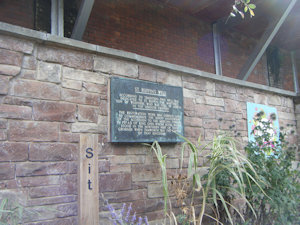 |
HOME - ENGLAND - WARWICKSHIRE
Dedication: Saint Ruffinus Location: Tamworth Status: lost |
St Ruffinus, a 7th century martyr from the locality, is reputed to have been the son of Wulfhere, the pagan King of Mercia. According to legend, he and his brother, St Wulfhad, both of whom had been raised as pagans, were led by a doe (which the brothers were hunting) to St Chad's cell at Lichfield. St Chad had been living off this animal's milk for some time, and, when the pagan princes arrived, he promptly converted them to Christianity, and baptised them in St Chad's Well. However, when their pagan father Wulfhere discovered that they had been converted, he was so angered that he resolved to kill them; their bodies were supposedly buried nearby at Stone, by St Ermenilda, their mother. Of course, whether there is any truth in this legend is uncertain, but it nonetheless seems that an authentic cult of the two brothers had developed in the area by the late medieval period.
A link between Tamworth and St Ruffinus, which perhaps lends some credibility to the tale, is the fact that Tamworth was once the centre of the Mercian kingdom. The medieval cult of the saint was clearly existent in the town by the 13th century, although it probably originated much earlier, if not in the late 7th century. Indeed, the earliest known reference to the existence of St Ruffin's Well, and thus to his cult in Tamworth, dates from 1276, when it was recorded that, according to Charles Ferrers Palmer, writing in The History of the Town and Castle of Tamworth (1845), "Will's Chelle obstruxit viam q' ducit ad fontem S'ci Ruffiany", meaning "William Chelle has blocked the road leading to St Ruffin's Well".
Unfortunately, very little is recorded of St Ruffin's Well from then onwards. R. C. Hope, in his Legendary Lore of the Holy Wells of England, published in 1893, asserted that the well was "almost entirely destroyed by fire" on the 15th of June, 1559; his source of information is not clear, however. According to him, it took "more than forty years" to restore the structure, although he contradicts himself slightly by suggesting that the well was "destroyed" at this time. If Hope's claims are true, then it seems quite possible that, given the time, the fire was not at all accidental; if so, then it is likely that the well was never actually "restored" (again, given the time), but was instead filled in or covered over.
This, at least, would explain why the well essentially vanished for three centuries. Hope reported that there had been no record of a public well in the vicinity for the last "300 years", and Charles Ferrers Palmer himself described the well as a thing of the past. However, by the time that Linsdall Richardson came to write his book on the Wells and Springs of Warwickshire in 1928, St Ruffin's Well had mysteriously reappeared. He described it as "a pool enclosed with brick walls, about 15 ft. by 12 ft." that "once presumably had a high-pitched roof over it", into which a "flight of six steps" descended from "a doorway in an adjacent building". According to him, this pool was "maintained by a spring". Undoubtedly, Richardson was referring to the pond marked on Ordnance Survey maps at SK2074703880. This did not appear on OS maps until 1957, although it certainly existed by the time that Richardson was describing it, so it appears that this was either an ornamental pond that was created in the 1920s, or that this really was St Ruffin's Well, brought back from the dead in the early 20th century.
However, despite the fact that Richardson clearly believed that this pond (or spring) was the lost holy well, the evidence to support this is lacking. The only information regarding the site's location that was given by either Charles Ferrers Palmer or R. C. Hope is that the well was located in the Warwickshire half of Tamworth; although this pond fits that description, there is nothing else to suggest that it was a medieval holy well. In other words, it is very possible, but not certain, that this was St Ruffin's Well. This pond was recently destroyed, and its site is now occupied by several raised flower beds. Nonetheless, it has become commonly accepted that this was the true holy well, and a plaque on its site declares it to have been so.
 |
Copyright 2025 britishholywells.co.uk